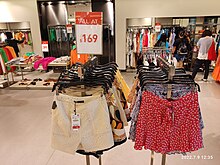
Back موضة سريعة Arabic Moda presta Catalan Fast fashion Czech Fast fashion Danish Fast Fashion German Moda pronta Spanish Pikamuoti Finnish Fast fashion French אופנה מהירה HE «Ֆասթ ֆաշըն» կամ «Արագ նորոյթ» HYW
This article has multiple issues. Please help improve it or discuss these issues on the talk page. (Learn how and when to remove these messages)
|

| Part of a series on |
| Clothing and the environment |
|---|
| Environmental impact of fashion |
Fast fashion is the business model of replicating recent catwalk trends and high-fashion designs, mass-producing them at a low cost, and bringing them to retail quickly while demand is at its highest. The term fast fashion is also used generically to describe the products of this business model, particularly clothing and footwear. Retailers who employ the fast fashion strategy include Primark, H&M, Shein, and Zara,[1] all of which have become large multinationals by driving high turnover of inexpensive seasonal and trendy clothing that appeals to fashion-conscious consumers.
Fast fashion grew during the late 20th century as manufacturing of clothing became less expensive—the result of more efficient supply chains, new quick response manufacturing methods, and greater reliance on low-cost labor from the apparel manufacturing industries of South, Southeast, and East Asia, where women make up 85–90% of the garment workforce. Labor practices in fast fashion are often exploitative, and due to the gender concentration of the garment industry, women are more vulnerable.[2]
Fast fashion's environmental impact has also been the subject of controversy. The global fashion industry is responsible for 8–10% of global carbon emissions per year, to which fast fashion is a large contributor. The low cost of production, favoring synthetic materials, chemicals, and minimal pollution abatement measures have led to excess waste.[3]
- ^ Cite error: The named reference
Monroe2021was invoked but never defined (see the help page). - ^ "Gender Based Violence in Garment Supply Chains". Global Labor Justice. 24 March 2020. Archived from the original on 13 April 2024. Retrieved 13 April 2024.
- ^ Niinimäki, Kirsi; Peters, Greg; Dahlbo, Helena; Perry, Patsy; Rissanen, Timo; Gwilt, Alison (7 April 2020). "The environmental price of fast fashion". Nature Reviews Earth & Environment. 1 (4): 189–200. Bibcode:2020NRvEE...1..189N. doi:10.1038/s43017-020-0039-9. S2CID 215760302. Archived from the original on 21 November 2022. Retrieved 14 December 2022.